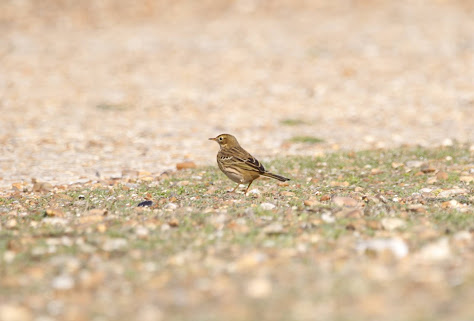As Autumn migration has really ramped up this past week, I decided to take a trip down to Landguard to see if there were any rare birds about. News of rarities are often posted on the internet, you know this and this bird is about, but its another thing entirely finding them out on the field, where it seems that no birds have turned up at all. The good news is that there were lots of birds present on this early October morning, even if in the end there was nothing unusual (that I saw).
Landguard is a migration hotspot, as a peninsular it juts out into the sea, which attracts tired migrants flying into this country. The reserve can be split into several sections. The observatory forms the centrepiece, sitting imperiously on a little hill, surrounded by trees which form a migrant trap. The northern section consists of grassland with scattered brambles, which thins out to grassy and lichen shingle to the south. The area is littered with old abandoned buildings, testament to man's failed attempts to develop the area.
Its these trees and bushes that migrants are attracted to, their first glimpse of food or shelter on a long flight. In the trees by the observatory several bird watchers had staked out a little patch of their own to birdwatch, and a little conversation elicited what was there, or more usually, what they had heard was there. As I arrived there were small numbers of bird watchers scattered around the site, but as time drew on, the place became invaded by joggers and dog walkers from the town to the north, which led to more disturbance.
In the trees, the usual birds were about, although in good numbers. They were mainly CHIFFCHAFFS and BLACKCAPS, with a few GOLDCRESTS, all in all, the usual fare. A small flock of BLACKBIRDS were newly arrived in, acting all bolshie as all foreign invaders new to the country do. There were ROBINS everywhere, again new migrants, its always a joy to watch them even if they are common birds, they aren't just making up the numbers, and the site would be desolate without them.
A walk to the river, by the cottage, again didn't produce much, just large numbers of commoner birds. Some BRENT GEESE moving up the river were my first for the winter. The open grassy areas near to the point held numbers of MEADOW PIPITS and LINNETS, and there were several WHEATEAR about. These bird were always on the move, and within a short space of time had probably already shipped out. Small numbers of SWALLOWS and HOUSE MARTINS were on the move trickling south down the site like sand in a time jar. Autumn can be a dynamic time of year with so many birds on the move it can really overawe you, this first hand experience of the power of nature. Birds can turn up at any time, especially on a coastal site, so its a game of luck at times when you're going to spot a bird. What was seen in the morning changes within a few hours.
As with a lot of things its a lottery birding in Autumn. It was good to see so many birds and to be witness to the awesome spectacle of migration. However I was a bit disappointed that I didn't get to see the rare birds supposedly about, and none of the other birders had either. Well that's one of the positives for you about bird watching, its not enough to just turn up in your car and be told where to point your binoculars. Field craft, is still paramount, at least for the time being, until they create a new app for that.






No comments:
Post a Comment